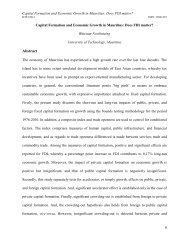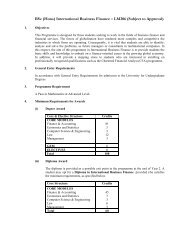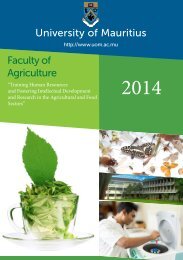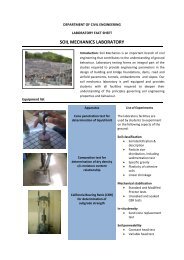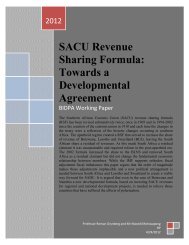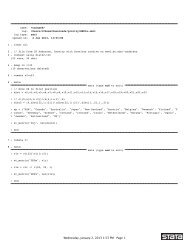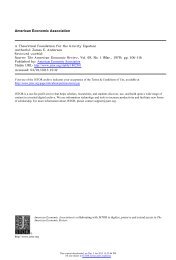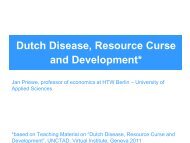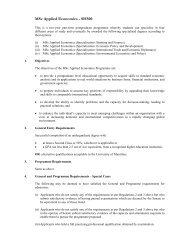THE LOG OF GRAVITY - the University of Mauritius
THE LOG OF GRAVITY - the University of Mauritius
THE LOG OF GRAVITY - the University of Mauritius
Create successful ePaper yourself
Turn your PDF publications into a flip-book with our unique Google optimized e-Paper software.
<strong>THE</strong> <strong>LOG</strong> <strong>OF</strong> <strong>GRAVITY</strong> 651TABLE 4.—RESULTS <strong>OF</strong> <strong>THE</strong> TESTS FOR TYPE <strong>OF</strong> HETEROSKEDASTICITY(p-VALUES)Test (Null Hypo<strong>the</strong>sis) Exports 0 Full SampleGNR (V[y i x] (x i )) 0.144 0.115Park (OLS is valid) 0.000 0.00027The formula to compute this effect is (e bi 1) 100%, where b i is<strong>the</strong> estimated coefficient.28To illustrate <strong>the</strong> role <strong>of</strong> remoteness, consider two pairs <strong>of</strong> countries, (i,j) and (k, l), and assume that <strong>the</strong> distance between <strong>the</strong> countries in eachpair is <strong>the</strong> same (D ij D kl ), but i and j are closer to o<strong>the</strong>r countries. In thiscase, <strong>the</strong> most remote countries, k and l, will tend to trade more betweeneach o<strong>the</strong>r because <strong>the</strong>y do not have alternative trading partners. SeeDeard<strong>of</strong>f (1998).The role <strong>of</strong> geographical distance as trade deterrent issignificantly larger under OLS; <strong>the</strong> estimated elasticity is1.17 (s.e. 0.03), whereas <strong>the</strong> Poisson estimate is 0.78(s.e. 0.06). This lower estimate suggests a smaller role fortransport costs in <strong>the</strong> determination <strong>of</strong> trade patterns. Fur<strong>the</strong>rmore,Poisson estimates indicate that, after controllingfor bilateral distance, sharing a border does not influencetrade flows, whereas OLS, instead, generates a substantialeffect: It predicts that trade between two contiguous countriesis 37% larger than trade between countries that do notshare a border. 27We control for remoteness to allow for <strong>the</strong> hypo<strong>the</strong>sis thatlarger distances to all o<strong>the</strong>r countries might increase bilateraltrade between two countries. 28 Poisson regressionssupport this hypo<strong>the</strong>sis, whereas OLS estimates suggest thatonly exporter’s remoteness increases bilateral flows betweentwo given countries. Access to water appears to beimportant for trade flows, according to Poisson regressions;<strong>the</strong> negative coefficients on <strong>the</strong> land-locked dummies can beinterpreted as an indication that ocean transportation issignificantly cheaper. In contrast, OLS results suggest thatwhe<strong>the</strong>r or not <strong>the</strong> exporter is landlocked does not influencetrade flows, whereas a landlocked importer experienceslower trade. (These asymmetries in <strong>the</strong> effects <strong>of</strong> remotenessand access to water for importers and exporters arehard to interpret.) We also explore <strong>the</strong> role <strong>of</strong> colonialheritage, obtaining, as before, significant discrepancies:Poisson regressions indicate that colonial ties play no role indetermining trade flows, once a dummy variable for commonlanguage is introduced. OLS regressions, instead, generatea sizeable effect (countries with a common colonialpast trade almost 45% more than o<strong>the</strong>r pairs). Language isstatistically and economically significant under both estimationprocedures.Strikingly, in <strong>the</strong> traditional gravity equation, preferentialtradeagreements play a much smaller—although still substantial—roleaccording to Poisson regressions. OLS estimatessuggest that preferential trade agreements raiseexpected bilateral trade by 63%, whereas Poisson estimatesindicate an average enhancement below 20%.Preferential trade agreements might also cause trade diversion;if this is <strong>the</strong> case, <strong>the</strong> coefficient on <strong>the</strong> tradeagreementdummy will not reflect <strong>the</strong> net effect <strong>of</strong> tradeagreements. To account for <strong>the</strong> possibility <strong>of</strong> diversion, weinclude an additional dummy, openness, similar to that usedby Frankel (1997). This dummy takes <strong>the</strong> value 1 wheneverone (or both) <strong>of</strong> <strong>the</strong> countries in <strong>the</strong> pair is part <strong>of</strong> apreferential trade agreement, and thus it captures <strong>the</strong> extent<strong>of</strong> trade between members and nonmembers <strong>of</strong> a preferentialtrade agreement. The sum <strong>of</strong> <strong>the</strong> coefficients on <strong>the</strong> tradeagreement and <strong>the</strong> openness dummies gives <strong>the</strong> net creationeffect <strong>of</strong> trade agreements. OLS suggests that trade destructioncomes from trade agreements. Still, <strong>the</strong> net creationeffect is around 40%. In contrast, Poisson regressions provideno significant evidence <strong>of</strong> trade diversion, although <strong>the</strong>point estimates are <strong>of</strong> <strong>the</strong> same order <strong>of</strong> magnitude underboth methods.Hence, even when allowing for trade diversion effects, onaverage, <strong>the</strong> Poisson method estimates a smaller effect <strong>of</strong>preferential trade agreements on trade, approximately half<strong>of</strong> that indicated by OLS. The contrast in estimates suggeststhat <strong>the</strong> biases generated by standard regressions can besubstantial, leading to misleading inferences and, perhaps,erroneous policy decisions.We now turn briefly to <strong>the</strong> results <strong>of</strong> <strong>the</strong> o<strong>the</strong>r estimationmethods. OLS on ln(1 T ij ) and tobit give very closeestimates for most coefficients. Like OLS, <strong>the</strong>y yield largeestimates for <strong>the</strong> elasticity <strong>of</strong> bilateral trade with respect todistance. Unlike OLS, however, <strong>the</strong>y produce insignificantcoefficients for <strong>the</strong> contiguity dummy. They both generateextremely large and statistically significant coefficients for<strong>the</strong> trade-agreement dummy. The first method predicts thattrade between two countries that have signed a trade agreementis on average 266% larger than that between countrieswithout an agreement. The second predicts that trade betweencountries in such agreements is on average 100%larger. NLS tends to generate somewhat different estimates.The elasticity <strong>of</strong> trade with respect to <strong>the</strong> exporter’s GDP issignificantly smaller than with OLS, but <strong>the</strong> correspondingelasticity with respect to importer’s GDP is significantlylarger than with OLS. The estimated distance elasticity issmaller than with OLS and bigger than with Poisson. Like<strong>the</strong> o<strong>the</strong>r methods, NLS predicts a significant and largeeffect for free-trade agreements.It is noteworthy that all methods, except <strong>the</strong> PPML, leadto puzzling asymmetries in <strong>the</strong> elasticities with respect toimporter and exporter characteristics (especially remotenessand access to water).To check <strong>the</strong> adequacy <strong>of</strong> <strong>the</strong> estimated models, weperformed a heteroskedasticity-robust RESET test (Ramsey,1969). This is essentially a test for <strong>the</strong> correct specification<strong>of</strong> <strong>the</strong> conditional expectation, which is performed bychecking <strong>the</strong> significance <strong>of</strong> an additional regressor constructedas (xb) 2 , where b denotes <strong>the</strong> vector <strong>of</strong> estimatedparameters. The corresponding p-values are reported at <strong>the</strong>bottom <strong>of</strong> table 3. In <strong>the</strong> OLS regression, <strong>the</strong> test rejects <strong>the</strong>hypo<strong>the</strong>sis that <strong>the</strong> coefficient on <strong>the</strong> test variable is 0. This



